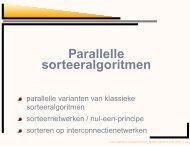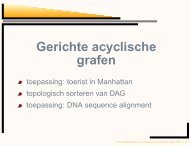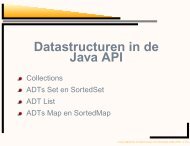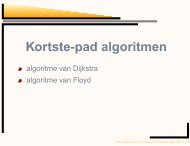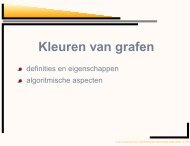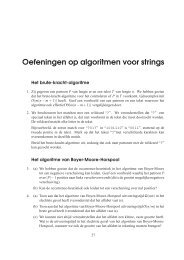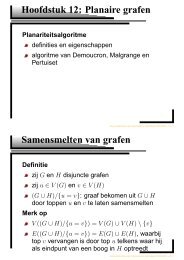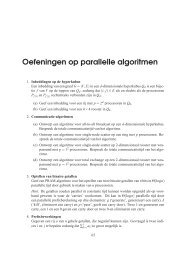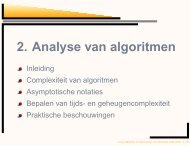Here - Combinatorial algorithms and algorithmic graph theory
Here - Combinatorial algorithms and algorithmic graph theory
Here - Combinatorial algorithms and algorithmic graph theory
You also want an ePaper? Increase the reach of your titles
YUMPU automatically turns print PDFs into web optimized ePapers that Google loves.
26 Generation of cubic <strong>graph</strong>s<br />
Figure 2.8: A prime <strong>graph</strong> which contains 2 lollipops.<br />
• G contains 1 reducible lollipop <strong>and</strong> no reducible non-adjacent edge diamonds.<br />
<strong>Here</strong> there are exactly 3 edges which can be chosen for expansion: the 3<br />
edges which are incident to the central vertex of the reducible lollipop. If<br />
the expansion is applied to other edges of the lollipop, the exp<strong>and</strong>ed <strong>graph</strong><br />
will not be prime.<br />
• G contains reducible 1 non-adjacent edge diamond <strong>and</strong> no reducible lollipops.<br />
The only way to destroy the reducible non-adjacent edge diamond without<br />
generating a new one (<strong>and</strong> where the exp<strong>and</strong>ed <strong>graph</strong> is still prime) is to<br />
apply the expansion to the edges where one vertex is an extremal vertex of<br />
the K4<br />
− of the reducible non-adjacent edge diamond <strong>and</strong> where the other<br />
vertex of the edge is the neighbour of that extremal vertex which is not part<br />
of the K4 − . So there are exactly 2 edges which can be chosen for expansion.<br />
• G contains no reducible lollipops <strong>and</strong> no reducible non-adjacent edge diamonds.<br />
In this case all edges which are no diamond edges are eligible for expansion.<br />
• In any other case the list of edges which are eligible for expansion is empty:<br />
since the edge diamond insertion operation only modifies one edge of the<br />
original <strong>graph</strong>, it cannot destroy more than 1 reducible lollipop or reducible<br />
non-adjacent edge diamond (except for the <strong>graph</strong> from Figure 2.8).<br />
The edge diamond insertion operation only modifies one edge in the original<br />
<strong>graph</strong> <strong>and</strong> the new edges of the exp<strong>and</strong>ed <strong>graph</strong> are irreducible since they share a<br />
vertex with a K4 − . Since we do not apply this operation to diamond edges (unless<br />
the parent <strong>graph</strong> is K 4 ), the exp<strong>and</strong>ed <strong>graph</strong> will be prime if the original <strong>graph</strong><br />
was. So for the edge diamond operation we do not have to check if the exp<strong>and</strong>ed<br />
<strong>graph</strong>s are prime.



